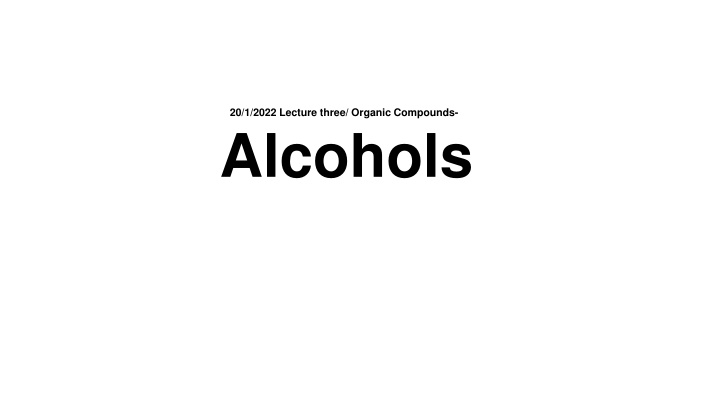
Alcohols: Types, Uses, and Respiration Processes
Explore the importance of alcohols in organic chemistry, their various types, uses such as solvent and fuel, and how human cells produce energy through aerobic and anaerobic respiration processes. Discover the effects of lactic acid buildup in muscle cells during exercise.
Download Presentation

Please find below an Image/Link to download the presentation.
The content on the website is provided AS IS for your information and personal use only. It may not be sold, licensed, or shared on other websites without obtaining consent from the author. If you encounter any issues during the download, it is possible that the publisher has removed the file from their server.
You are allowed to download the files provided on this website for personal or commercial use, subject to the condition that they are used lawfully. All files are the property of their respective owners.
The content on the website is provided AS IS for your information and personal use only. It may not be sold, licensed, or shared on other websites without obtaining consent from the author.
E N D
Presentation Transcript
Alcohols Alcohols are some of the most important molecules in organicchemistry. They contain the hydroxyl functional group bonded to a carbon atom of an alkyl, or substituted alkyl group(R). There are three types of alcohols Primary, Secondary, &Tertiary alcohol. Figure1 Figure1. Figure1: Alcohol Classification. Uses of Alcohols ? Ethanol is a solvent: it s a widely safe solvent, in medicine used to dissolve organic compounds that are insoluble in water especially to extract active constituents from inert parts of crude drugs. ? Ethanol is an effective in killing organisms like bacteria, fungi, and viruses, so it is commonly used as hand sanitizer. gels. Notice that Ethanol spirits are unfit to drink. Ethanol spirits consist of a mixture of Ethanol with a small quantity of poisonous methanol, and possibly some color added. Ethanol spirits are unfit to drink.
Ethanol spirits consist of a mixture of Ethanol with a small quantity of poisonous methanol, and possibly some color added. Ethanol spirits are unfit to drink. ? Ethanol can be used as a fuel. it burns to produce carbon dioxide and water, as shown in the equation below: CH3CH2OH + 3 O2 2 CO2+ 3 H2O. Can Human Cell Produce Energy? In respiration process there are two types of cell reactions for gaining energy depending on the presence of oxygen they are: 1- Aerobic Respiration Reactions. 2- Anaerobic Respiration Reactions. 1- Aerobic Respiration Reactions. Mitochondria is the cells energy factory, where electrons produced and used for pumping the protons H+1 to the inner membrane space of mitochondria, by the specific enzyme named ATP synthase (adenosine triphosphate synthase).
The electrons flow to oxygen in presence of proton H+1and ATP synthase, then forming ATP, and H2O, also decreasing the effect of acidity. Figure 2. Figure 2: The electrons flow to oxygen in presence of proton H+1 in the inner mitocondria membrane, and ATP synthase, then forming ATP, and H2O. 2- Anaerobic respiration:( in absence of oxygen) This type of reactions is done in absence of oxyge or not happen, in mitochondria, for most prokaryotes that live under environmental conditions. In Red Blood Cells The environmental conditions which lack oxygen uses an aerobic respiration. Red Blood Cells don t have mitochondrea in its matrix, and use electron transport chain without presence of oxygen as electron acceptor , so can not form Adenosine Tri Phosphate (ATP).
Build-Up of Lactic Acid in Muscle Cells Less oxidizing molecules such as Sulfate SO4-, or Nitrate NO3-, are used as electron acceptors instead of Oxygen. Consequently, less energy is formed per molecule of glucose during anaerobic respiration. Glucose is not completely broken down, so less energy is released than during aerobic respiration. This is done during exercises.There is a build-up of lactic acid in muscle cells during exercise then transported through bloodstream to the liver, to be oxidized into carbon dioxide, and water later.Lactate accumulate in muscles was responsible for soreness caused by exercise. The simple equation for lactic acid fermentation in muscle is: glucose ---glycolysis---> 2 pyruvate --- fermentation--> 2 lactic acid. Alcohol fermentation producing ethanol, by two steps in presence of yeast. Alcohol fermentation Its a process, in which, Nicotinamide Adenine Dinucleotide NADH donates its electrons to a derivative of pyruvate, Its a process, in which, Nicotinamide Adenine Dinucleotide NADH donates, its electrons to a derivative of pyruvate, producing ethanol, by two steps in presence of yeast.Figure3. Figure3:Alcohol fermentation
In the first step, removing of carboxyl group from pyruvate, and as carbon dioxide CO2, producing a two-carbon molecule called Acetaldehyde CH3CHO. In the second step, Nicotinamide Adenine Dinucleotide NADH gives its electrons to acetaldehyde, regenerating NAD+, and ethanol. Alcohol and Antibiotics Antibiotics are chemical compounds can fight bacterial infections either by killing bacteria or slowing and suspending its growth. They do this by: attacking the wall or coating surrounding bacteria, interfering with bacteria reproduction. Completely avoid drinking alcohol when taking drugs. Antibiotics can cause dangerous reaction with alcohols, Also causing symptoms of being sick. Alcoholism should avoid avoid drinking alcohol completely, while taking medications such as Doxycycline this is used, to treat bacterial infections in many different parts of the body known to interact with alcohol, it should not be taken by people with liver problems. The signs of Alcohol with Antibiotics reaction side effects are: 1-Racing heart rate. 2-Sever headache. 3-Reddening and warming of skin
Blood Alcohol Concentration (BAC) Alcohol is swallowed to reach the stomach then a small amount pass by stomach wall to the blood circulation. About 20 percent of the alcohol from a single drink moves directly to the blood vessels, while most alcohol through intestine and to blood circulation (to reach all over the body). Blood alcohol concentration (BAC) is a measure of the alcohol amount that is present in the blood, based on the volume of alcohol consumed over a given period of time. The BAC of 10% means that an individual's blood supply contains one part alcohol for every 1000 parts blood. There are many factors that affect BAC, and not everyone s BAC rises and falls at the same rate. That means even if two people drink the same amount of alcohol, over the same length of time, their BACs can still be different FACTORS INFLUENCING BAC: 1. Quantity: the more standard drinks, the higher the BAC. 2. Gender: 3. Body composition 4. Body weight 5. Stomach contents
The Effect Of Alcohol On Human Body Enhance narrowing of Blood Vessels Alcohol causes blood vessels to widen and relax, so you get flushed. The lose of body heat and this in turn may cause body temperature to go too low. The Effect Of Alcohol On Human Body Long-term chronic alcohol consumption increases blood pressure by production of cortisol, a stress hormone that causes blood vessels to narrow. This, in turn, causes heart to pump harder to circulate blood throughout the body. The Effect Of Alcohol as Hangover Perhaps one of the best known short term effects alcohol has on the body is the hangover. Alcohol dehydrates and expands blood vessels in the brain and body. This produces a headache. The stomach detects toxins in the alcohol and wants to expel them so may get nausea and vomiting. The liver works overtime to process alcohol, so it doesn't release sugar into the bloodstream. So may feel weak and shaky. The Effect Of Alcohol On Brain Alcohol reach's the brain in a short time. Within 90 seconds in a healthy circulation rate, it will affect all the organs systems, and interferes with the brain s communication pathways,
interferes with the brains communication pathways, by crossing even the blood-brain barrier, which shields the brain from toxic substances in the blood, supplies brain tissues with nutrients, and filters harmful compounds from the brain back to the bloodstream. The interfering with the brain s communication pathways, can affect brain function, and who looks resulting in change mood and behavior, also reduce the brains ability for controlling behaviors. The Effect Of Alcohol On Heart Heavy drinking affects electrical impulses that are responsible for heart beat. Long-term heavy drinking can permanently alter heart beat and increase the risk of cardiomyopathy. Excess drinking of alcohol increases the risk of stroke and high blood pressure, too. It hurts the Liver Liver breaks down ethanol alcohol (CH3CH2OH). Most of the ethanol is broken down in the liver by an enzyme called alcohol dehydrogenase (ADH), which transforms ethanol into a toxic compound called acetaldehyde (CH3CHO),
Acetaldehyde(CH3CHO), a known carcinogen, this toxins, results in the buildup of fatty tissue in the liver, buildup processes of fatty tissue causing damages. This impairs blood flow through the liver, and liver cells damaged, it forms scars and doesn t work well. This is called cirrhosis. Increase the Stomach acid Alcohol affects stomach lining and increases the production of stomach acid. When acid builds up while drinking, so may get nauseated and throw up. Long-term heavy drinking may lead to stomach ulcers. High levels of stomach acid impair ability to feel hungry. Heavy drinkers often also develop nutrient deficiencies. Induce Pancreatitis The pancreas produces insulin and compounds to assist the intestines in breaking down food. Alcohol impairs. This process. Insulin is released from the beta cells in pancreas in response to rising glucose in bloodstream. After eat a meal, any carbohydrates have eaten are broken down into glucose and passed into the bloodstream. The pancreas detects this rise in blood glucose and starts to secrete insulin. Toxins in alcohol lead to inflammation in the pancreas. If the process continues long-term, the pancreas may lose the ability to make insulin, which may lead to the development of diabetes. Long-term heavy alcohol consumption also increases the chance of developing pancreatic cancer.
During digestion, pancreas makes pancreatic juices called enzymes. These enzymes break down sugars, fats, and starches. Effect of Toxins in alcohol appear when pancreas enzymes that are normally released into the digestive tract and activate by alcohol, when they enter the small intestine can become active in the pancreas, and as a result, the pancreas begins to digest itself. This may form of diabetes. Diabetes results from the body's immune system attacking the insulin- producing beta cells in the pancreas. The beta cells become damaged and, over time, the pancreas stops producing enough insulin to meet the body's needs. Alterations causing thin bone Heavy alcohol consumption alters calcium levels and it affects the levels of hormones that are necessary for the growth of new bone. Alcohol consumption makes bone thin and fragile, which is known as osteoporosis. Alcohol impairs blood flow to muscles and interferes with the growth of new muscle tissue. Habitual excessive alcohol consumption results in a decrease in muscle mass and decreased strength.














